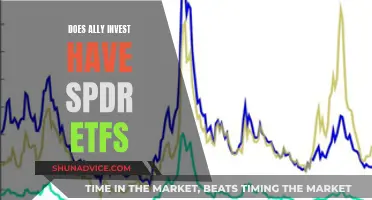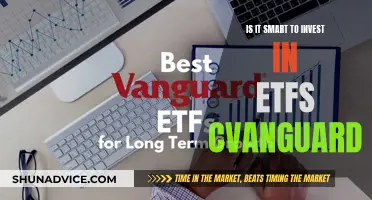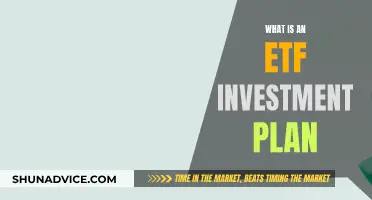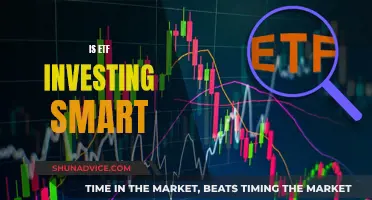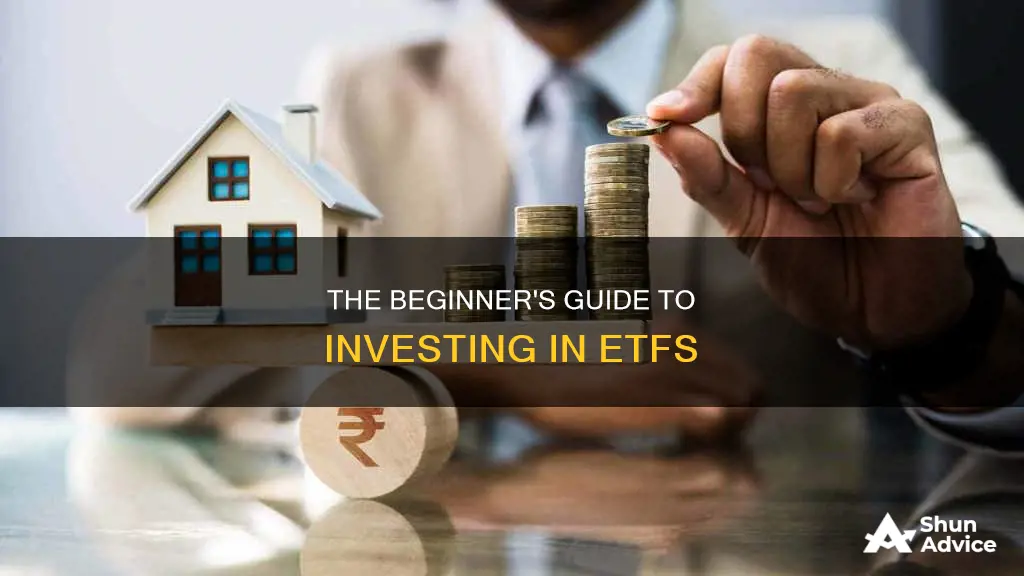
Exchange-traded funds (ETFs) are an increasingly popular investment option, providing an easy and low-cost way to enter the stock market. ETFs are a type of security that tracks a stock index, sector, commodity, bond, or range of assets. They are traded on the stock market, and when you buy an ETF, you are buying shares of a portfolio that tracks the yield and return of its corresponding index or asset.
ETFs are a great option for beginners as they are relatively simple to understand, can generate good returns, and are more affordable than other investments. They are also more diversified than investing in individual stocks, which means they are often safer.
This guide will cover everything you need to know about ETFs, including how they work, the different types available, the pros and cons, and how to choose and invest in the right ETFs for your portfolio.
| Characteristics | Values |
|---|---|
| Definition | Exchange-traded funds (ETFs) |
| How they work | Investors buy shares of ETFs, and the money is used to invest according to a certain objective. |
| How to buy | Via an online broker, from the ETF provider, or through a brokerage account |
| Types | Passive and active ETFs; physically-backed and synthetic ETFs |
| Fees | Management expense ratio (MER); brokerage fees |
| Benefits | Provide exposure to a variety of stocks, bonds, and other assets; take the guesswork out of stock investing; more liquid than mutual funds; easy to buy and sell |
| Risks | An ETF's return may differ from the index it's designed to track; liquidity issues; the ETF will close; market or sector risk; currency risk; liquidity risk; tracking errors |
What You'll Learn

Understanding ETF basics
Before investing in your first ETF, there are several key concepts to understand.
Passive vs. Active ETFs
ETFs can be either passive or active. Passive ETFs, also known as index funds, track a stock market index, such as the S&P 500. Active ETFs, on the other hand, hire portfolio managers to actively invest their money with the goal of beating an index's performance. Passive ETFs are generally cheaper than their active counterparts.
Expense Ratios and Dividends
ETFs charge fees, known as expense ratios, which are listed as an annual percentage. For example, a 1% expense ratio means you'll pay $10 in fees for every $1,000 invested. ETFs also pay dividends, which can be automatically reinvested through a dividend reinvestment plan (DRIP).
ETF Taxes
If you buy ETFs in a standard brokerage account, they may result in taxable income. Any gains from selling an ETF will be taxed according to capital gains tax rules, and any dividends received will likely be taxable. However, if you invest in ETFs through an IRA, you won't have to worry about these taxes.
Minimum Investment Requirements
ETFs don't typically have minimum investment requirements. However, since they trade on a per-share basis, you'll need at least the current price of one share to get started, unless your broker offers fractional share purchases.
Pros and Cons of ETFs
ETFs provide exposure to a variety of stocks, bonds, and other assets at a low cost. They take the guesswork out of stock investing and allow investors to match the market's performance over time. Additionally, they are more liquid and easier to buy and sell than mutual funds. However, ETFs may have lower return potential than investing in individual stocks, and they do incur management fees.
XBI SPDR S&P Biotech ETF: Unity Biotechnology Investment Analysis
You may want to see also

How to buy ETFs
Step 1: Open a Brokerage Account
You'll need a brokerage account to begin buying and selling ETFs. Most online brokers now offer commission-free ETF and stock trades, so cost shouldn't be a major consideration. Compare each broker's features and platform. If you're a new investor, consider choosing a broker that offers an extensive range of educational features.
Step 2: Choose Your First ETFs
Passive index funds are generally the best option for beginners. They are cheaper than actively managed funds, and most actively managed funds don't beat their benchmark index over time.
Step 3: Let Your ETFs Do the Hard Work for You
It's important to remember that ETFs are typically designed to be maintenance-free investments. Avoid the temptation to frequently check your portfolio and make emotional, knee-jerk reactions to major market moves.
Step 4: Execute Your Order
The process for buying ETFs is very similar to the process for buying stocks. Navigate to the "trading" section of your brokerage's website and buy the ETF using its ticker symbol. Before executing your order, double-check that everything is correct, including the ticker symbol, order type, and share number.
Step 5: Relax
Congratulations, you've just bought your first ETF! These funds can help form the basis of a well-diversified portfolio and serve as the first step in a long-lasting investment in the markets. There's no need to compulsively check how your ETF is performing, but you can access that information through your brokerage's website or by typing the ticker symbol into a search engine.
Africa ETF: A Guide to Investing in the Continent's Future
You may want to see also

Pros and cons of ETFs
Pros of ETFs
- ETFs are diversified investments, meaning they reduce the risk of having all your eggs in one basket.
- They are fairly liquid, making them easy to buy and sell.
- They are tax-efficient compared to mutual funds, as they are more passively managed and have fewer trades. This results in smaller capital gains and losses.
- They are low-cost, with lower expense ratios than mutual funds.
- They are flexible, allowing investors to wager on declining markets by short-selling ETFs.
- They are transparent, as the fund's holdings are disclosed each day.
- They are simple to understand and can generate good returns without much expense or effort.
- They are easy to invest in, as they can be purchased through a brokerage account during trading hours.
- They are traded on major exchanges throughout the day, giving investors more control over how and when they invest.
- They are low-risk, as they hold a basket of stocks or other securities.
Cons of ETFs
- ETFs are not free, and there may be trading fees, expense ratios, and other costs involved.
- They may not be suitable for hands-on investors who want to be extremely specific about their investments.
- They might not offer the same level of diversification as investing in individual stocks, and some sectors may be limited to large-cap stocks.
- They may not offer the same high dividend yields as individual stocks.
- They could be harder to pick for specific investment mixes or goals.
- They may not offer partial shares, making investing more complicated.
ETFs: An Introduction to Exchange-Traded Funds Investing
You may want to see also

Different types of ETFs
There are two main types of ETFs: passive and active. Passive ETFs are the most common and are designed to track the performance of an index. The index prescribes inclusion requirements, methodology, and the weighting of each security within the ETF. Active ETFs, on the other hand, are actively managed by professionals with the aim of outperforming an index.
- Equity ETFs own stocks in companies and can be further classified into subtypes such as international ETFs, sector ETFs, dividend ETFs, and market-cap index ETFs.
- Bond/Fixed-Income ETFs hold a portfolio of bonds or a single bond issued by government treasuries, municipalities, private companies, and/or financial institutions.
- Commodity ETFs invest in raw materials such as agricultural goods, energy, and precious metals, usually through futures contracts or secure vaults.
- Currency ETFs track an index of a single currency or a basket of multiple currencies.
- Real Estate Investment Trust (REIT) ETFs invest in specific types of real estate or a broader range of properties and are known for their high yield due to the requirement to pay out 90% of their taxable income to shareholders.
- Inverse ETFs profit when a particular index performs poorly.
- Leveraged ETFs use leverage to double or triple the returns of a particular index.
- Socially Responsible ETFs focus on sustainable investment and ethical objectives.
- Thematic ETFs allow investors to benefit from megatrends, which are waves of change that permanently transform the world on multiple levels. Examples include ageing population ETFs, artificial intelligence ETFs, and climate change ETFs.
- Smart Beta ETFs track indices that use stock selection and weighting criteria other than market capitalisation, such as dividend yield, company size, or specific accounting figures.
A Guide to Investing in ASX 200 ETFs
You may want to see also

How to compare ETFs
When comparing ETFs, there are several factors to consider. Firstly, it's important to understand the different types of ETFs available, such as passive and active ETFs. Passive ETFs track a stock index like the S&P 500, while active ETFs hire portfolio managers to actively invest their money, with the goal of beating the index's performance.
- Expense ratios: ETFs charge fees, known as expense ratios, which are typically expressed as an annual percentage. Lower expense ratios are generally preferable as they result in lower costs for investors.
- Commissions: These are fees charged per transaction when buying or selling an ETF. While many brokers have eliminated commission fees, it's important to check beforehand.
- Volume: This indicates the popularity of an ETF and is measured by the number of shares traded over a given period.
- Holdings: This refers to the individual companies the ETF invests in. It's important to review the top holdings to understand the underlying investments.
- Performance: While past performance doesn't guarantee future results, comparing the historical performance of similar funds can provide valuable insights. Look at long-term performance over three, five, or ten years rather than just one year.
- Trading prices: ETFs trade like stocks, so it's important to consider the current trading prices to determine how many shares you can afford to buy.
- Tax implications: If you buy ETFs in a standard brokerage account, they may result in taxable income. Any gains from selling an ETF will typically be taxed according to capital gains tax rules, and dividends may also be taxable. On the other hand, investing in ETFs through an IRA can offer tax advantages.
- Liquidity: Some ETFs may have liquidity issues, making them harder to sell when needed. It's important to consider the trading volume and ensure the ETF has sufficient liquidity to meet your investment needs.
- Diversification: ETFs offer diversification by providing exposure to a variety of stocks, bonds, and other assets. However, over-diversification can also be a concern, leading to portfolio bloat and reduced expected returns.
By considering these factors, you can make informed decisions when comparing different ETFs and selecting the ones that align with your investment goals, risk tolerance, and preferences.
Choosing a Brokerage for ETF Investing: Key Factors
You may want to see also
Frequently asked questions
An exchange-traded fund (ETF) is a fund that is listed and traded on stock exchanges, like the NYSE and Nasdaq. ETFs are a collection of stocks, bonds, or commodities, and each share you purchase gives you exposure to a variety of assets.
You can buy ETFs through a brokerage account, just like you would with stocks. You can also buy directly from the ETF provider or through a robo-advisor, which builds and manages an investment portfolio for you.
ETFs are a low-cost way to gain exposure to a diverse range of assets and reduce risk. They are also highly liquid and transparent, making it easy to buy and sell during trading hours.


